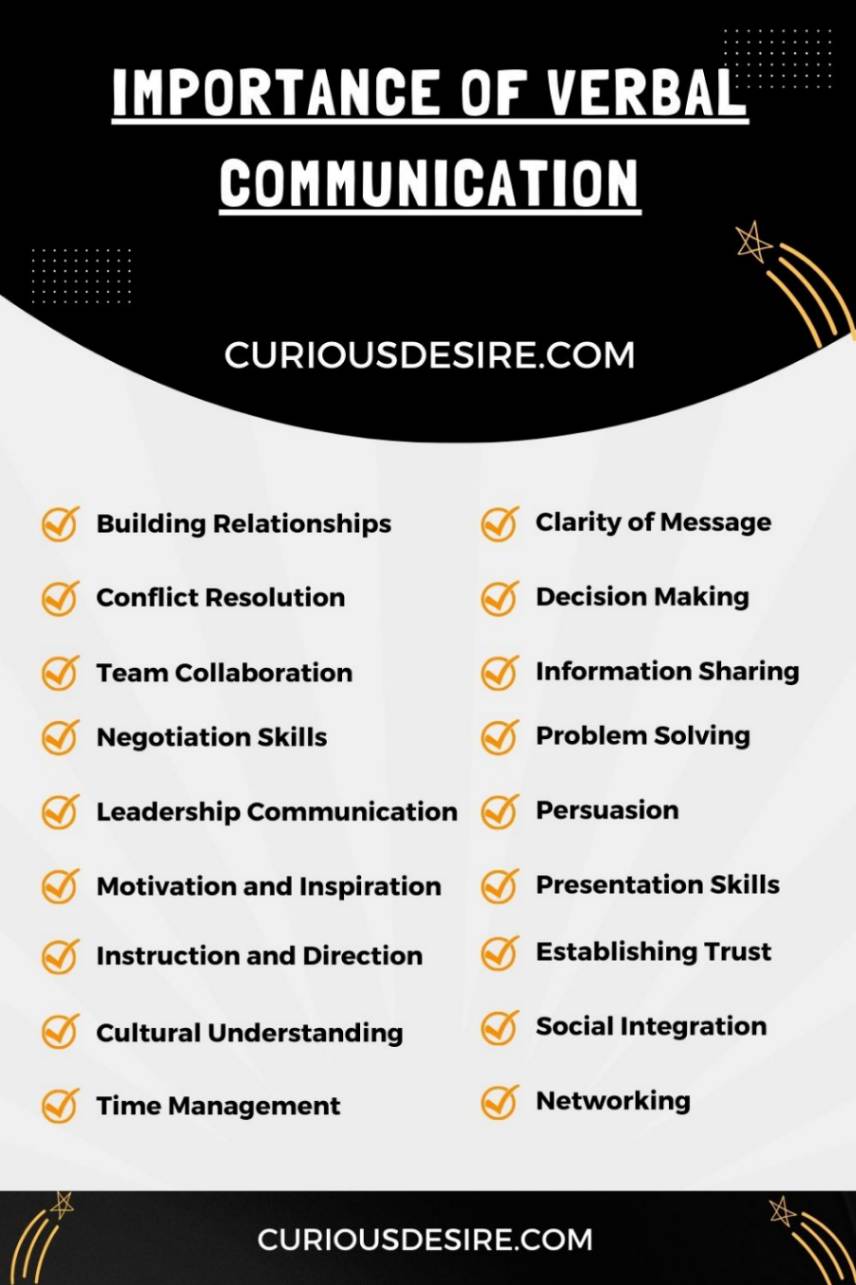Effective communication is the cornerstone of successful human interaction, and verbal communication plays an important role in conveying thoughts, ideas, and emotions.
In our daily lives, both personally and professionally, the ability to express ourselves verbally is a fundamental skill that shapes relationships, promotes collaboration, and drives positive outcomes.
This article explores the profound importance of verbal communication by exploring 20 key aspects.
From building trust and resolving conflicts to enhancing leadership and promoting cultural understanding, each facet contributes to the intricate tapestry of effective communication.
The following are the 5 most common reasons for the importance of verbal communication:
- Building Relationships
- Conflict Resolution
- Effective Expression of Ideas
- Decision Making
- Clarity of Message

1. Clarity of Message
Clear communication is vital as it ensures that our ideas are easily understood by others. When conveying information verbally, providing a straightforward and unambiguous message is important.
For instance, when making plans with friends, offering clear details like the venue, time, and any additional information minimizes the risk of misunderstandings.
The importance lies in preventing confusion and promoting effective communication, both in personal and professional contexts. Clear messages enable better understanding, helping build stronger connections and facilitating successful interactions.
2. Effective Expression of Ideas
Think of effective expression of ideas like drawing a clear map during a team talk about a project. It’s about breaking down the complicated plan into simple steps and goals so everyone gets where we’re headed.
When everyone understands, it’s like giving each team member the power to share their thoughts, making the whole team work together better and come up with new ideas. This clear understanding helps everyone work towards the same goal and turns ideas into reality.
3. Building Relationships
Building relationships is a bit like growing a garden of connections. When you regularly chat with friends, share stories, and ask about their day, it’s like planting seeds of trust. This ongoing friendly talk creates a strong base for good friendships.
The cool thing about using words well here is that it not only keeps friendships positive but also helps them grow stronger over time, making our social lives better.
4. Conflict Resolution
When it comes to solving problems between people, using words well is like having a handy tool. Imagine expressing worries calmly and listening to what others say during an argument as if you’re slowly fixing a tangle of threads.
It’s important because this calm talking helps people find common ground, sort out issues, and keep relationships healthy, even when there are differences.
5. Decision Making
Think of decision-making like putting together a big puzzle with your team. In meetings, talking openly about ideas, thoughts, and concerns is like adding pieces to the puzzle. The cool part is that when everyone contributes, the puzzle shows the full picture, helping the team make smart choices.
The important thing is that good talking helps everyone work together and makes sure different ideas are considered, leading to smart decisions that match what the whole team wants to achieve.
This talking and deciding together help the team succeed and reach its goals smoothly.
6. Information Sharing
Think of information sharing as being a bit like passing around a helpful guide. Imagine you have useful tips, and by sharing them clearly with others, everyone gains valuable knowledge.
This helps the team stay on the same page, prevents confusion, and ensures everyone can contribute effectively. For instance, sharing important project updates during a team meeting allows everyone to be well-informed and aligned in their work.
7. Team Collaboration
Team collaboration is like working together on a giant puzzle. Effective communication involves openly discussing ideas, opinions, and concerns, ensuring that everyone’s piece fits well into the larger picture.
This collaborative communication ensures that the team functions smoothly, capitalizing on the strengths of each member. For example, in a brainstorming session, team members openly sharing their thoughts can lead to innovative solutions that benefit everyone.

8. Negotiation Skills
Imagine negotiation skills as a friendly conversation where everyone tries to find a win-win solution. Good communication here involves expressing needs clearly and listening to others to reach a compromise.
For instance, during a business deal, effective negotiation skills involve articulating terms and understanding the other party’s perspective, leading to an agreement that satisfies both sides.
9. Problem-Solving
Problem-solving is like working together to fix a broken machine. Effective communication in this context involves discussing the issue openly, sharing ideas on how to fix it, and collaborating on a solution.
For example, in a team facing a challenge, open communication allows members to share their perspectives, leading to a collective effort to solve the problem and keep things running smoothly.
10. Leadership Communication
Leadership communication is like guiding a team on a journey. Effective communication here involves conveying the vision, providing direction, and inspiring the team.
For instance, a leader addressing the team with a motivational speech not only sets the tone but also promotes a sense of unity and purpose, encouraging everyone to work towards a common goal.
Good leadership communication ensures that the team is motivated, informed, and ready to take on challenges.

11. Motivation and Inspiration
Visualize motivation and inspiration as injecting a dose of excitement into a team.
Effective communication in this space involves not just sharing a vision but making it thrilling, expressing confidence in each team member’s abilities, and highlighting the significance of their contributions.
For instance, when a leader uplifts the team spirit during a challenging project, it goes beyond boosting morale; it creates a positive atmosphere that motivates everyone to collectively tackle and conquer challenges, promoting a united and determined spirit.
12. Feedback and Evaluation
Consider feedback and evaluation as tools for helping teammates grow. Good communication in this realm goes beyond merely pointing out mistakes; it involves offering practical advice, acknowledging achievements, and providing encouragement.
When a manager engages in a post-project conversation with an employee, celebrating successes and suggesting areas for improvement, it not only encourages a culture of continual learning but also nurtures a supportive environment that values ongoing development.
13. Persuasion
Imagine persuasion as the art of getting others to see things your way. Effective communication here means not just presenting ideas clearly but also addressing concerns and highlighting the positive aspects.
For instance, in a team discussion about a new project idea, persuasive communication is the ability to influence opinions by emphasizing the potential positive impact and success, thereby aligning everyone’s support behind the proposal.
14. Presentation Skills
Think of presentation skills as the ability to share information in a captivating way. Strong communication in presentations involves not only being clear but also adding interest and organization to the mix.
During a business talk, good presentation skills include making eye contact, using visuals effectively, and delivering information in a way that captures and holds the audience’s interest, ensuring that the message not only gets across but is also understood and remembered.
15. Instruction and Direction
Picture instructions and direction as providing a clear roadmap for tasks. Effective communication in this domain goes beyond giving orders; it means offering straightforward guidance, and ensuring that everyone comprehends their roles and responsibilities.
For example, when a manager explains a new process to a team, it involves providing simple step-by-step directions, clarifying expectations, and making certain that each team member understands their role.
This clarity in communication is essential for promoting teamwork and ensuring tasks are carried out smoothly and efficiently.

16. Cultural Understanding
Cultural understanding is like possessing a key that unlocks doors to varied perspectives. Effective communication in this context involves not only recognizing but also respecting and learning about diverse cultures within a team.
By taking the time to understand and appreciate each team member’s cultural background, a workplace cultivates an environment of inclusivity.
This not only minimizes misunderstandings but also promotes collaboration by leveraging the richness that diverse perspectives bring to the table.
17. Establishing Trust
Establishing trust is comparable to constructing a robust bridge between people. Communication plays a pivotal role in this process by emphasizing honesty, reliability, and the consistent fulfillment of promises.
When a team leader openly communicates, shares information transparently, and follows through on commitments, it lays a foundation of trust among team members.
This, in turn, promotes a positive and reliable working relationship, where individuals feel confident in one another’s abilities and intentions.
18. Social Integration
Social integration involves making every team member feel like a valued part of the collective. Effective communication in this area entails inclusivity, encouraging open dialogue, and recognizing the input of each team member.
For example, organizing team-building activities or regular informal catch-ups promotes social integration by creating occasions for team members to connect, share ideas, and build stronger relationships.
This not only enhances the working atmosphere but also contributes to a collaborative and supportive team culture.

19. Networking
Networking is comparable to expanding one’s professional circle. Effective communication in networking involves introducing oneself clearly, expressing interests, and actively listening to others.
During professional events, approaching new individuals with a friendly introduction and engaging in meaningful conversations can lead to valuable connections.
This not only broadens professional relationships but also opens doors for potential collaborations and career opportunities, emphasizing the importance of effective communication in professional growth.
20. Time Management
Time management is akin to steering the ship of your schedule. Effective communication in time management involves setting clear priorities, expressing deadlines, and coordinating tasks efficiently.
For example, in a team project, communicating timelines and task dependencies ensures everyone is on the same page, minimizing delays and fostering a sense of shared responsibility.
This emphasizes how clear communication plays an important role in optimizing productivity and contributing to the overall success of projects within a team.
Enhancing Verbal Communication Skills: Practical Tips for Success
Effective communication is the cornerstone of successful interactions, and verbal communication plays an important role in conveying ideas and building connections.
From managing nervousness to adapting communication to diverse audiences, each tip provides actionable insights for individuals seeking to improve their verbal communication prowess.
Let’s step into these tips that can significantly impact the quality of our everyday conversations and professional interactions.
1. Practice Active Listening
Active listening involves fully concentrating, understanding, responding, and remembering what others are saying. By actively engaging with the speaker, you not only show respect but also build a more meaningful connection.
Non-verbal cues, such as maintaining eye contact and nodding, indicate genuine interest and contribute to a positive communication environment.
2. Expand Vocabulary
Expanding your vocabulary not only enhances your ability to express ideas clearly but also allows you to tailor your communication to different audiences.
A rich vocabulary allows you to convey nuances and subtleties, making your messages more precise and impactful.
3. Speak Clearly and Slowly
Clarity in speech is essential for effective communication. Articulating words clearly and speaking at a moderate pace ensures that your message is easily comprehensible.
Providing pauses allows your audience to process information, reducing the likelihood of misunderstandings.
4. Maintain Eye Contact
Eye contact establishes a connection and conveys sincerity and confidence. When you maintain eye contact during a conversation, you demonstrate attentiveness and openness. This visual connection promotes trust and strengthens the overall impact of your verbal communication.
5. Use Non-Verbal Cues
Non-verbal cues, including facial expressions and gestures, add depth to verbal messages. These cues provide additional context and emotional nuances, enriching the communication experience.
Understanding and appropriately using non-verbal communication contribute to more effective and nuanced interactions.
6. Practice Pronunciation
Clear pronunciation is vital for ensuring that your message is understood accurately. Regular practice, especially with words that pose pronunciation challenges, sharpens your articulation skills. Pronouncing words correctly enhances the overall clarity of your verbal communication.
7. Be Mindful of Tone and Pitch
Tone and pitch influence the emotional tone of your message. By adjusting your tone to match the context and varying your pitch, you can convey enthusiasm, seriousness, or empathy. A varied vocal range makes your communication more engaging and expressive.
8. Ask Clarifying Questions
Seeking clarification through questions demonstrates your commitment to understanding and ensures that you and your audience are on the same page.
Asking questions not only clears up potential misunderstandings but also encourages a more interactive and collaborative conversation.
9. Use Positive Language
Choosing positive language contributes to a constructive and uplifting communication environment. Positive words and expressions create a more optimistic atmosphere, encouraging collaboration and a positive response from others.
10. Control Nervousness
Managing nervousness is essential for confident communication. Deep breathing and relaxation techniques help alleviate anxiety, allowing you to convey your message more effectively. Building confidence through these strategies contributes to overall communication success.
Conclusion
In conclusion, improving our verbal communication skills is like learning a superpower that helps us connect better with others. By actively listening, speaking clearly, and using positive words, we can make our conversations more enjoyable and effective.
Remembering to be open to learning and seeking feedback will help us keep getting better. So, let’s practice these tips, and over time, we’ll become even better communicators, making our interactions smoother and more meaningful.
Importance of Verbal Communication FAQs
1. Why is active listening important in verbal communication?
Active listening is crucial because it shows respect and helps us understand others better. When we listen carefully, we can respond thoughtfully, making conversations more meaningful.
2. How does using positive language impact verbal communication?
Using positive words makes conversations friendly and encourages a good atmosphere. It helps build connections and makes people feel happier during communication.
3. Why is practicing pronunciation essential for effective communication?
Pronouncing words correctly ensures that others can understand us better. It boosts clarity and prevents confusion in conversations.
4. How does maintaining eye contact contribute to effective verbal communication?
Eye contact shows that we are paying attention and interested in the conversation. It helps create a connection and builds trust with the person we are talking to.
5. Why is it important to adapt communication to different audiences?
Adapting our language to different audiences ensures everyone understands us. It shows respect for others’ backgrounds and makes communication more inclusive.
6. How can technology help improve verbal communication skills?
Technology, like video recording, allows us to see how we communicate and identify areas for improvement. Practicing virtual communication helps us adapt to various situations.
7. Why is asking clarifying questions an effective communication strategy?
Asking questions ensures we understand and are understood correctly. It helps prevent misunderstandings and promotes clearer communication.
8. What role does being open to learning play in verbal communication?
Being open to learning means we are willing to improve and adapt. It allows us to grow as communicators, making our interactions more effective over time.